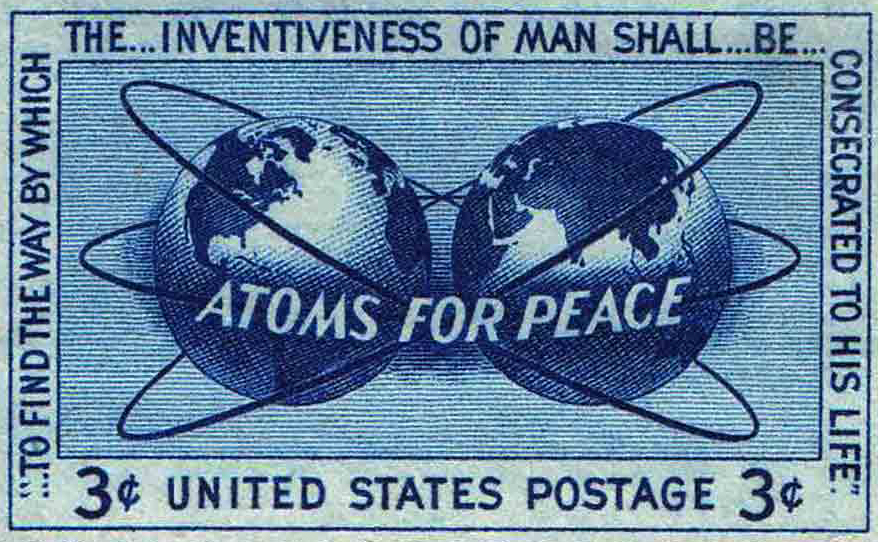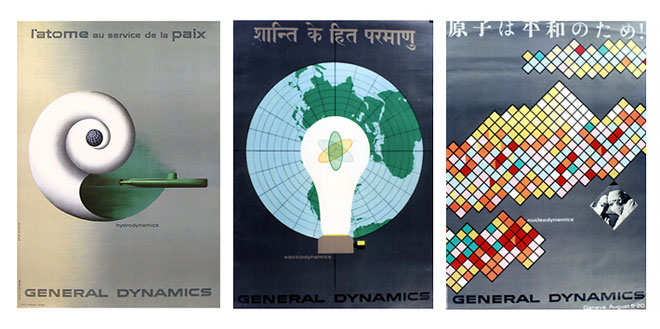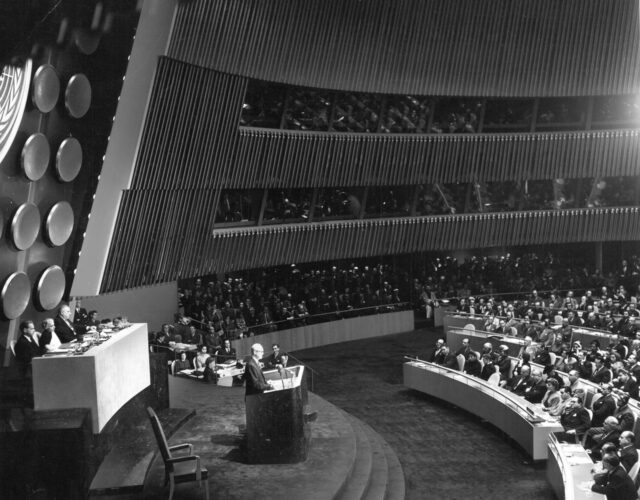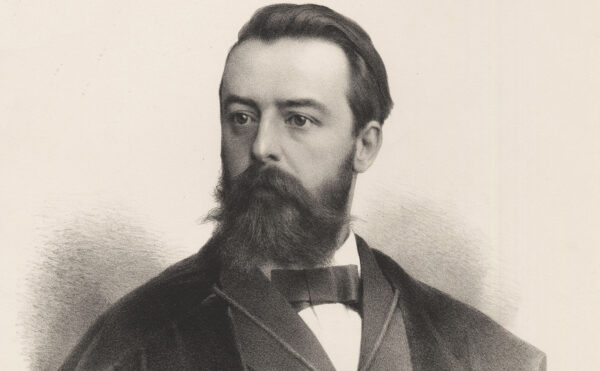On the cold, rainy morning of July 16, 1945, a group of scientists and soldiers gathered in New Mexico’s Jornada del Muerto desert. Atop a 100-foot steel tower they had placed a large metal ball studded with plugs and wires. The “gadget,” as they called it, was a code word for their secret weapon. Inside it sat another globe made of high explosives, and inside that was a core of subcritical plutonium. This device was the first nuclear explosive, a prototype bomb built to end a war.
The atomic age began with a bang: the great mass of humanity first knew a threshold had been crossed when it witnessed the incineration of two cities. But the newly harnessed atom had a peaceful aspect as well. Not just a global sword of Damocles, it could also be, as Walt Disney later put it, “our friend, the atom.” Nuclear technology could advance medicine and agriculture. It could, as envisioned by Lewis Strauss, chairman of the U.S. Atomic Energy Commission (AEC), provide the world with energy “too cheap to meter.” If J. Robert Oppenheimer and his Promethean colleagues had given mankind the means for species suicide, maybe they had also provided a means of salvation.
Dwight Eisenhower was a military man, a former World War II commander drafted into a presidential campaign. He entered office in 1953 as the first chief executive elected after the advent of the bomb, when both scientific and governmental authorities had just begun to grapple with its ramifications. Eisenhower recognized how the world of war had changed. That December, in a speech before the United Nations, he said, “I feel impelled to speak today in a language that in a sense is new—one which I, who have spent so much of my life in the military profession, would have preferred never to use. That new language is the language of atomic warfare.”

But in that same speech Eisenhower proposed another vision: the peaceful, controlled distribution of nuclear technology to all the countries of the world. In exchange for the potentially life-changing knowledge, countries would agree not to pursue atomic weapons. In outline it was a simple plan but a revolutionary one; it was, as Eisenhower put it, an attempt to ensure “this greatest of destructive forces can be developed into a great boon for the benefit of all mankind.”
Atoms for Peace, as the program came to be called, appeared simple on its surface, yet it evolved from a complex constellation of motives and objectives. It was neither wholly utopian nor baldly pragmatic. The program was in many ways a product of its time, but even today we face the consequences of those early decisions.
The Martial Atom
When President Franklin Roosevelt died in early 1945, his successor, Harry Truman, knew nothing about the Manhattan Project, then in the final stages of developing the atomic bomb. In his diary he described it as “the most terrible bomb in the history of the world,” likening it to “fire destruction” found in biblical prophecy. Truman ultimately made the decision to use the fruits of Oppenheimer’s work in Japan.
For Truman the weapon was a secret revealed only once he had risen to the most powerful position in the country. Likewise, the bomb was a revelation for the public and the U.S. Congress, whose members quickly scrambled to comprehend and control this new technology after the war’s end. The scientists and military men, having worked on it for years, had a head start on the politicians and the public when it came to understanding the new era they had birthed. Consequently, those already in the know drove much of the early debate.
During the war nuclear knowledge was a closely held secret, one cultivated by the scientists but ultimately controlled by the military. Many of the scientists involved with the Manhattan Project bristled under that authority; others, particularly Oppenheimer, saw their duty as merely to produce the technology, leaving political and military decision making to those in charge. But these scientists knew their work would become public one day, and they had begun to think through the ramifications of a nuclear world.
One crucial question was whether the United States and its allies could maintain a nuclear monopoly, and if so, for how long. Some strategists saw the bomb as a hard-won advantage, one the Soviets would take years to match. These planners estimated the Soviet Union wouldn’t have its own nuclear weapons for a generation. Others recognized the bomb as a piece of technology—applied scientific knowledge—unlikely to remain secret for long. (The question of nuclear monopoly became moot in 1949 when the Soviets, thanks to a combination of scientific talent and espionage, detonated their own nuclear weapon.)
Deciding who ultimately controlled the bomb defined early attempts at regulation, such as the May-Johnson bill of late 1945. The bill, produced almost entirely by Truman’s advisers, compelled many scientists to voice opposition to military control of the technology. Opposition grew largely out of the belief that during peacetime, control of nuclear technology—particularly atomic weapons—should reside in the hands of civilian leaders. Yet even those in favor of civilian control agreed that “security” meant “secrecy” and that it was best to keep other countries from developing nuclear technology. The debate turned on which group could better maintain nuclear secrecy: civilians or the military.
During the war nuclear knowledge was a closely held secret, one cultivated by the scientists but ultimately controlled by the military.
In the face of such scientific criticism the May-Johnson bill withered in committee, replaced with a more civilian-focused proposal. The debate culminated on August 1, 1946, with the passage of the Atomic Energy Act, which established the AEC, the civilian body that would control nuclear information. The law also created a unique legal category: that of “restricted data.” Any information related to atomic weapons, the production of nuclear material, or nuclear energy would be “born classified.” Such data was so important to national security, the thinking went, that it would be preemptively classified and shared only with the commission’s approval. That effectively froze out allies of the United States, including Canada and the United Kingdom. Both had contributed knowledge and manpower to the Manhattan Project and had received wartime promises that the technology would be shared.
But Congress granted the AEC unprecedented regulatory powers for developing, producing, and controlling atomic energy in all its forms, while imposing its own strict controls. In addition to the technology-transfer freeze and the blanket secrecy of the “born classified” category, the FBI would have to closely vet scientists and contractors accessing AEC information. (In one of the era’s sad ironies Oppenheimer himself was stripped of clearance in 1954 over suspicions he was sympathetic to Communism.) The AEC took over the development of the U.S. atomic arsenal; research took place in government-owned labs and was tightly controlled by the commission. Congress had given the AEC the power to shape the world’s postwar atomic future—largely in secret—and that’s exactly what it did.
The Peaceful Atom
A week after Eisenhower’s election, on a foggy, sodden morning, he arrived at the clubhouse of the Augusta National Golf Club in Georgia. There the president-elect was met by Roy B. Snapp, the secretary of the AEC. Snapp wore a gun, a requirement given the sensitive information he carried: a memorandum detailing the current state of U.S. nuclear technology. He was to brief Eisenhower on its contents, then burn the document.
In the half-dozen years since the AEC’s inception the atomic world had changed dramatically. Though tasked with developing peaceful as well as military nuclear technology, most of the AEC’s early work involved weapons research. In 1948 it began testing new designs on Enewetak Atoll in the Pacific Ocean; the tests led to a growing stockpile of nuclear weapons. The following September, however, the Soviet Union detonated its own nuclear device. In response the AEC starting building a more powerful thermonuclear weapon, often called a hydrogen bomb because part of its energy comes from the fusion of hydrogen; this project became one of the largest in U.S. history, involving several years and several billion dollars spent at research facilities across the country.
When Snapp met with Eisenhower, he revealed to the president-elect that the project had succeeded. On November 1, 1952, the United States had detonated the first full-scale thermonuclear device. The blast was equivalent to 10 million tons of TNT—500 times as powerful as the bomb dropped on Hiroshima. Elugelab Island, where the new hydrogen bomb had been tested, was vaporized, leaving only a watery crater 1,500 yards across.
The news troubled Eisenhower. The failure to internationalize nuclear technology—as some scientists had hoped to do—had started an arms race between the United States and the Soviet Union. Eisenhower, the former general, understood the strategic necessity of a nuclear arsenal but saw no need “for us to build enough destructive power to destroy everything.” He didn’t fear the Soviets or their arsenal, but he worried that as atomic bombs became cheaper and more prevalent, they might be viewed as just another conventional weapon waiting to be used. The deadlier hydrogen bomb only worried him more.
Eisenhower had come to the meeting with ideas of his own, particularly about atomic energy. Charles A. Thomas, president of the Monsanto Chemical Company, had suggested to Eisenhower a larger role for private industry in developing nuclear-power plants; the AEC, some industrialists felt, had not done enough to successfully commercialize nuclear power. Eisenhower, believing that government should allow private industry to carry out economic policy wherever possible, was inclined to agree.
So President Eisenhower entered office with his own beliefs about atomic secrecy. Early in his term he launched Operation Candor with the express goal of explaining to the American public the risks and rewards of the atomic age. The administration attempted to balance secrecy with transparency, as Eisenhower recognized the tactical advantage of keeping the Soviets guessing but saw the nuclear question as about more than just weaponry.

Operation Candor may have represented an evolution in political thinking, but Eisenhower was ready to make an even more serious break with the past. On December 8, 1953, he went before the U.N.’s General Assembly to give a 20-minute speech. He began by warning that nuclear technology would only grow cheaper and that atomic weapons would become available to more countries, possibly all of them. Devastating surprise attacks, he cautioned, would become a possibility. Yet he also spoke of redirecting nuclear research to peaceful ends. He proposed an International Atomic Energy Agency that would collect, store, and distribute fissionable materials—a responsibly managed “uranium bank.” He described in glowing terms the future prospects of nuclear power. Finally, he pledged the United States’ “determination to help solve the fearful atomic dilemma—to devote its entire heart and mind to find the way by which the miraculous inventiveness of man shall not be dedicated to his death, but consecrated to his life.” As his speech concluded, the delegates broke into applause.
Why had Eisenhower broken so completely with Harry Truman’s strategy of U.S. control and secrecy? In some ways he hadn’t. In 1946 Truman asked the U.S. Department of State to develop an international control plan for fissionable material; the resulting report declared fissionable material produced by atomic power could too easily be diverted to military use. But by late 1953 the Soviets had their own atomic arsenal and even a hydrogen bomb. Truman’s strategy of clamping down on nuclear knowledge hadn’t worked. The nuclear arms race was well under way. The United States would continue to participate in the race, while also reassuring its European allies that it didn’t intend to provoke a nuclear apocalypse. Eisenhower’s canny strategy emphasized the atom’s peaceful uses while allowing development of atomic weapons of even greater destructive power. Atoms for Peace was, like virtually all politics, intended partly as a propaganda maneuver.
[Eisenhower] didn’t fear the Soviets or their arsenal, but he worried that as atomic bombs became cheaper and more prevalent, they might be viewed as just another conventional weapon waiting to be used.
But this propaganda was more than mere words. Within a year the U.S. Atomic Energy Act was revised: the United States would now provide nuclear-power technology to countries that pledged not to develop nuclear weapons. Much in the way the atom had been split, American policy makers tried to split the military and peaceful uses of nuclear technology, and with equally world-changing results. The United States began training foreign scientists; it declassified reams of nuclear research; it sponsored nuclear reactors worldwide and provided allies with fissionable material. It was a remarkable shift from the preceding years of secrecy, one designed as a show of America’s leadership and peaceful generosity, contrasted with the Soviet’s bellicosity. The name itself, Atoms for Peace, could be considered a kind of preemptive strike aimed at winning hearts and minds before the Soviet Union could introduce a similar program.
Fallout
In just a few years the U.S. nuclear strategy shifted from near-absolute secrecy to that of remarkable openness. And while they understood the risk of this change, U.S. policy makers believed they could manage it. They enacted safeguards designed to cleave peaceful use from military development and monitored the movement of nuclear materials. They rejected requests for assistance from countries deemed untrustworthy or disingenuous.
With hindsight it is easy to recognize how authorities overestimated both their judgment and their capability. India provides an illuminating case study: after lobbying hard for assistance, in 1955 it was the first country to receive nuclear material under the program. On May 18, 1974, the message reached New Delhi: “The Buddha is smiling.” India had detonated its first nuclear device, 350 feet beneath the desert. A Canadian-supplied reactor provided easily diverted plutonium for the effort, while Atoms for Peace had helped train India’s nuclear scientists. Homi Sethna, who would later become chairman of the Indian Atomic Energy Commission, declared, “I can say with confidence that the initial cooperation agreement itself has been the bedrock on which our nuclear program has been built.” The test enraged Pakistani officials, who committed themselves to developing a nuclear arsenal with their own Canadian reactor and Atoms for Peace–trained scientists.
While critics can use such cases to label Atoms for Peace a naïve failure—a project that actually increased the proliferation it sought to curb—doing so means neglecting the program’s positive effects. Following Truman’s untenable position of absolute secrecy (spurred by estimates that the Soviet Union would take a generation to develop its own nukes), Atoms for Peace established the groundwork for future international nonproliferation efforts. It made possible regulated trade in nuclear technology and materials with accompanying safeguards. Out of it arose the International Atomic Energy Agency, which remains the global body for monitoring nuclear proliferation. As weapons-proliferation expert Peter R. Lavoy notes, “Indeed, the 1968 nuclear Nonproliferation Treaty can be seen as a refined, negotiated expression of Atoms for Peace and follow-on efforts by the Eisenhower administration.”
With Operation Candor, Eisenhower had sought to describe the nuclear situation to the world; with Atoms for Peace he prescribed a new regime, one based on transparency rather than secrecy that acknowledged the nuclear threat while envisioning the “peaceful atom.” We are still wrestling with the downside of the atomic age, as news headlines describe secret nuclear-weapons programs in Iran and North Korea and the radioactive aftereffects of a tsunami-battered nuclear-power plant in Fukushima, Japan. Eisenhower likely would have recognized the complexities of such a world as ours. Despite accusations that Atoms for Peace was hopelessly idealistic, it appears in hindsight to be a pragmatic, if imperfect, strategy. Eisenhower knew the bomb would be around for a long time and that we would continue to struggle in its shadow. He ended his presidency with a speech acknowledging as much: “As one who knows that another war could utterly destroy this civilization, which has been so slowly and painfully built over thousands of years—I wish I could say tonight that a lasting peace is in sight.”




